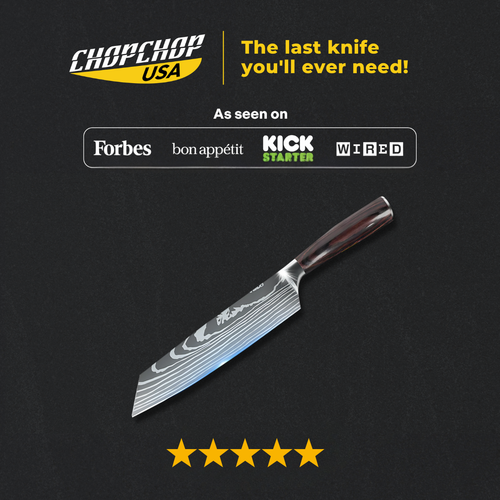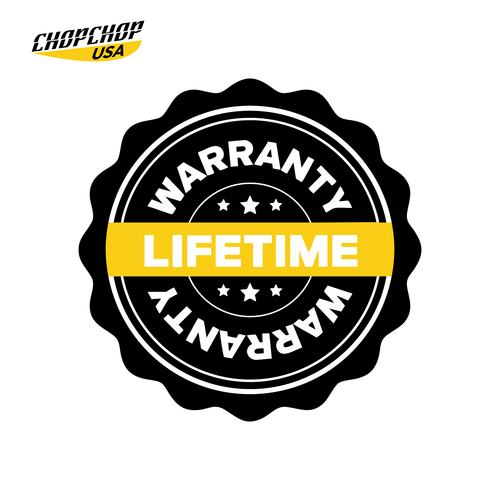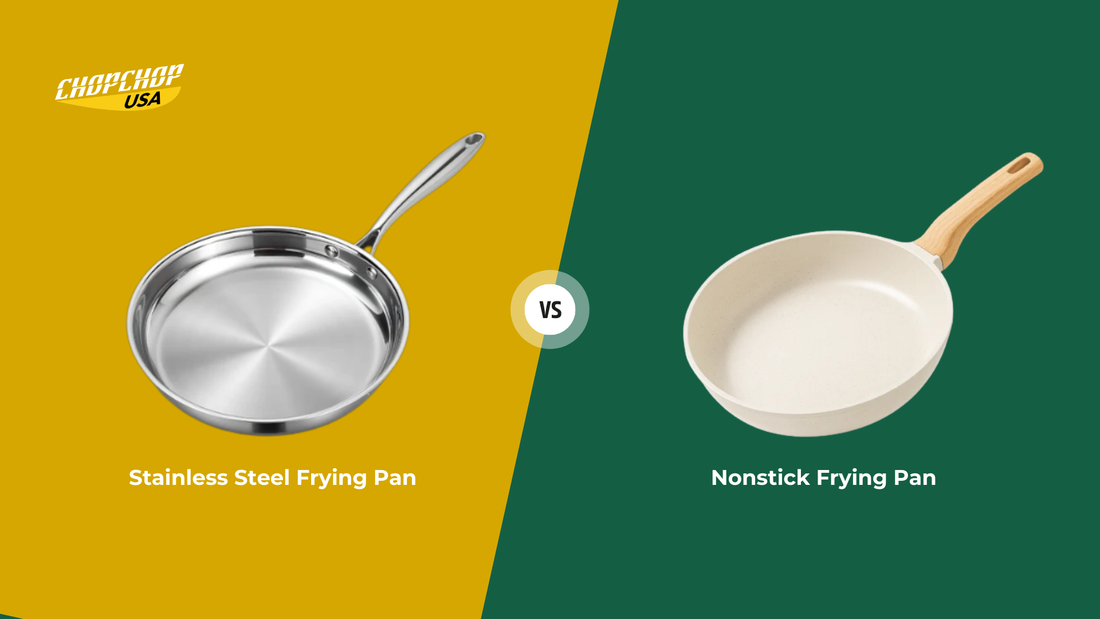Stainless Steel vs Nonstick Cookware: Which Is Better? It depends on your cooking style and needs. Stainless Steel vs Nonstick Cookware offers two distinct cooking experiences — stainless steel excels at high-heat cooking and browning, while nonstick cookware makes cooking delicate foods and cleanup easier.
In this guide, ChopChop USA will break down the benefits, drawbacks, and ideal uses of both types, helping you choose the right cookware for your kitchen. Whether you’re searing a steak or flipping pancakes, understanding Stainless Steel vs Nonstick Cookware ensures better results every time.
What Is Stainless Steel Cookware?

Stainless steel cookware is made from a durable blend of iron, chromium, and sometimes nickel, creating a sleek, corrosion-resistant surface. Many stainless steel pans feature an aluminum or copper core for improved heat conductivity.
Unlike nonstick pans, stainless steel doesn’t use a coating, making it stain-resistant and long-lasting. It’s a favorite among professional chefs for sautéing, searing, and deglazing, and because it’s non-reactive, it won’t affect the taste of acidic or alkaline foods — a key difference in Stainless Steel vs Nonstick Cookware performance.
What Are the Benefits of Stainless Steel Cookware?

Stainless Steel vs Nonstick Cookware comparisons often highlight durability and performance, and stainless steel is prized for its strength, versatility, and professional-grade results. It’s a reliable choice for home and professional chefs alike, offering exceptional durability and consistent cooking results across a wide range of dishes.
Durability
One of the biggest advantages of stainless steel cookware is its outstanding durability. These pans are built to handle years of daily cooking without warping, chipping, or rusting.
They can withstand metal utensils, high heat, and thorough cleaning, making them ideal for both home kitchens and professional settings. With proper care, stainless steel cookware can last a lifetime — a smart, long-term investment for any cook who values the quality difference between Stainless Steel vs Nonstick Cookware.
Versatility
Stainless steel is one of the most versatile materials in the kitchen. It performs beautifully for searing meats, sautéing vegetables, boiling pasta, simmering sauces, and even baking in the oven.
It also makes it easy to create flavorful sauces and gravies by deglazing after cooking. Whether you’re cooking on the stovetop or finishing a dish in the oven, stainless steel adapts to a wide range of techniques and recipes — making it a standout in the Stainless Steel vs Nonstick Cookware debate.
High Heat Resistance
Stainless steel cookware excels under high temperatures, making it perfect for tasks that require strong, even heat. It’s excellent for searing steaks, caramelizing onions, or browning chicken to perfection.
Its ability to handle intense heat without damage makes it a trusted choice for cooks who enjoy bold flavors and precise cooking results, and this is where Stainless Steel vs Nonstick Cookware truly differs.
Non-Reactive Surface
Another major benefit is its non-reactive nature. Stainless steel doesn’t react with acidic or alkaline foods such as tomatoes, wine, or citrus, ensuring that your dishes retain their authentic flavor and color.
This makes it especially useful for sauces, reductions, and slow-cooked recipes where purity of taste matters most — a clear edge in Stainless Steel vs Nonstick Cookware discussions.
What Are the Drawbacks of Stainless Steel Cookware?
While stainless steel cookware offers excellent performance and longevity, it does come with a bit of a learning curve. Because it isn’t naturally nonstick, you’ll need to use a bit of oil or butter to keep food from sticking — especially when cooking delicate items like eggs or fish.
It also heats up quickly and retains heat well, so temperature control and proper preheating are key to great results. In Stainless Steel vs Nonstick Cookware comparisons, this difference in ease of use often matters most to beginner cooks.
Stainless steel pans can be slightly heavier and may require a little more effort to clean, particularly if food residue is left on the surface. However, once you get the hang of it, many cooks find that stainless steel’s responsiveness, durability, and professional feel make it well worth the practice.
Best Uses for Stainless Steel Cookware
Stainless steel is best for searing meats, sautéing vegetables, boiling pasta, and making sauces. Its high heat tolerance and non-reactive surface make it ideal for browning, deglazing, and recipes that involve acidic ingredients.
It’s perfect for home chefs and professional cooks who prioritize durability and versatility in their kitchen tools — another point in favor of stainless steel when comparing Stainless Steel vs Nonstick Cookware.
What Is Nonstick Cookware?

What Are the Benefits of Nonstick Cookware?

Ease of Use
Nonstick cookware makes cooking and cleanup a breeze. Foods like eggs, pancakes, and fish slide right off the surface without sticking. This reduces frustration in the kitchen and allows even beginner cooks to achieve great results without special techniques — a key advantage in Stainless Steel vs Nonstick Cookware comparisons.
Less Oil
Because food doesn’t stick, you need minimal oil or butter when cooking. This makes nonstick cookware ideal for those looking to prepare healthier meals with lower fat content.
Maintenance
Cleaning nonstick pans is simpler than stainless steel. Most nonstick pans are dishwasher safe, though hand washing is recommended to extend the coating’s life. The smooth surface prevents food residue buildup, saving time and effort — a benefit often highlighted in Stainless Steel vs Nonstick Cookware discussions.
Affordability
Nonstick cookware is often more affordable upfront compared to high-quality stainless steel. While it may need to be replaced more frequently, it provides a convenient and accessible solution for everyday cooking needs, especially for home cooks who prioritize ease over extreme durability.
What Are the Drawbacks of Nonstick Cookware?
Nonstick pans are less durable than stainless steel and can be easily scratched by metal utensils. Overheating can damage the coating and release harmful fumes. They also offer poor browning and searing compared to stainless steel — one of the biggest contrasts in Stainless Steel vs Nonstick Cookware.
Over time, nonstick coatings degrade and may need replacement every few years. High-heat cooking, like searing meats or reducing sauces, is not recommended, limiting their versatility for professional-style cooking.
Best Uses for Nonstick Cookware
Nonstick pans excel at cooking delicate foods like eggs, pancakes, and fish. They’re ideal for low-fat cooking and quick meals. Their easy cleanup and lightweight design make them perfect for busy kitchens or beginner cooks who want stress-free cooking. The Stainless Steel vs Nonstick Cookware difference is clear here — nonstick is all about convenience and control.
Stainless Steel vs Nonstick Cookware: 5 Key Differences

When deciding between Stainless Steel vs Nonstick Cookware, it helps to understand how they differ in performance, care, and longevity. Both have unique strengths that make them suited to different cooking styles and preferences.
Durability
Stainless steel cookware is known for its exceptional strength and long lifespan — many sets can last for decades with proper care. It resists scratches, dents, and rust, even with frequent use and metal utensils. Nonstick pans, on the other hand, are designed for convenience and lighter use. While modern coatings are more durable than ever, nonstick cookware typically lasts around 3–10 years before it may need replacement.
Cooking Performance
Stainless Steel vs Nonstick Cookware shines differently depending on the recipe. Stainless steel excels at tasks that require high heat, such as searing, browning, and deglazing, while nonstick cookware is unbeatable for delicate foods like eggs and fish.
Heat Resistance
Stainless steel can handle very high temperatures, making it suitable for oven use and intense stovetop cooking. Nonstick cookware performs best at medium to medium-high heat, which preserves the coating and ensures even cooking. This makes it ideal for everyday dishes that don’t require extreme temperatures.
Maintenance
Nonstick cookware offers effortless cleanup — most food residue wipes away easily, saving time in the kitchen. Stainless steel requires a bit more care, especially after high-heat cooking or browning. However, it can withstand more rigorous cleaning and even metal utensils, giving it long-term resilience.
Cost and Value
Stainless steel cookware often comes with a higher upfront cost but pays off over time thanks to its durability and longevity. Nonstick cookware is generally more affordable initially, offering great value for convenience and ease of use, though it may need periodic replacement depending on frequency of use and care.
Stainless Steel vs Nonstick Cookware: Which Is Better?
So, nonstick vs stainless steel cookware, which is better? There’s no one-size-fits-all answer. Stainless steel is ideal for high-heat cooking, durability, and versatile kitchen use. Nonstick cookware is perfect for low-fat cooking, quick meals, and easy cleanup.
Many home chefs find that having both types in the kitchen ensures they’re prepared for any recipe. Your choice ultimately depends on your cooking style, budget, and the types of dishes you prepare most often.
Do You Need Both?
Most kitchens benefit from having both stainless steel and nonstick cookware. Stainless steel handles high-heat tasks, browning, and acidic ingredients, while nonstick pans simplify cooking delicate foods and reduce cleanup time.
Together, they provide maximum versatility, allowing you to cook a wide range of recipes efficiently and safely. Investing in both types ensures you can tackle any dish with the right tool, enhancing your culinary results and overall kitchen experience.
Ready To Upgrade Your Cookware With ChopChop USA?
Upgrading your cookware can completely transform your cooking experience — from the way your food tastes to how easy cleanup feels afterward. At ChopChop USA, we combine innovation, quality, and performance to create cookware that meets the needs of both home cooks and culinary professionals. Whether you love the classic performance of stainless steel, the effortless release of nonstick, or the eco-friendly benefits of ceramic, ChopChop USA has the perfect pan for you.
ChopChop USA Stainless Steel Frying Pan

Crafted for durability and professional performance, the ChopChop USA Stainless Steel Frying Pan delivers precision cooking and long-lasting reliability. It’s perfect for searing, sautéing, browning, and deglazing — making it a must-have for those who love restaurant-quality results at home.
Key Features:
- Premium 3-Ply Construction: Combines stainless steel with an aluminum core for even heat distribution and superior temperature control.
- High Heat Performance: Safe for stovetop and oven use, allowing seamless transitions from searing to baking.
- Non-Reactive Surface: Preserves the natural flavor of your ingredients, ideal for cooking acidic foods like tomato sauces or citrus-based dishes.
- Durable and Scratch-Resistant: Designed to handle metal utensils and daily use without warping or discoloration.
- Ergonomic Handle: Riveted, stay-cool handle ensures comfort and control during cooking.
Size Available:
- 9.45" (24 cm) – 1.82 lbs (825 g)
- 10.24" (26 cm) – 2.16 lbs (980 g)
- 11.02" (28 cm) – 2.47 lbs (1120 g)
- 11.81" (30 cm) – 2.84 lbs (1290 g)
ChopChop USA Hybrid Nonstick Frying Pan

Experience the best of both worlds with the ChopChop USA Hybrid Nonstick Frying Pan, expertly crafted from premium stainless steel and engineered with advanced micro-carving technology.
This innovative design combines the strength and heat control of stainless steel with the effortless food release of nonstick, giving you professional-level performance and everyday convenience in one pan. Whether you’re searing, sautéing, or frying, you’ll enjoy powerful cooking results with minimal cleanup — no sticking, no compromise.
Key Features:
- Micro-Carved Stainless Steel Grid: Unique hybrid surface features a laser-etched stainless steel pattern that protects the nonstick coating and boosts durability.
- Premium Stainless Steel Construction: Ensures superior strength, lasting shine, and resistance to rust and corrosion.
- Exceptional Heat Distribution: Aluminum core delivers fast, even heating for precise temperature control and consistent cooking results.
- Metal Utensil Safe: Durable hybrid surface resists scratches, making it safe to use with metal utensils.
- Effortless Food Release: Perfect for delicate foods like eggs, fish, or stir-fries — all with little to no oil.
- Oven and Dishwasher Safe: Designed for versatility and easy maintenance, ideal for modern everyday cooking.
Size Available:
ChopChop USA Ceramic Frying Pan

For those who prefer a naturally nonstick and chemical-free option, the ChopChop USA Ceramic Frying Pan offers a clean, eco-friendly cooking experience. Designed with a smooth ceramic coating, it delivers effortless food release while maintaining even heat for consistent results every time.
Key Features:
- Natural Ceramic Coating: Free from PTFE, PFOA, and other harmful chemicals — safe for you and the environment.
- Effortless Cleaning: Nonstick ceramic surface allows for quick, easy cleanup after every meal.
- Even Heating Base: Provides balanced heat distribution to prevent hot spots and ensure perfect cooking results.
- Lightweight and Comfortable: Easy to maneuver with a soft-grip, stay-cool handle for everyday use.
- Low-Oil Cooking: Ideal for health-conscious meals that don’t sacrifice flavor or texture.
Size Available:
- 9.45" (24 cm) – 1.76 lbs (800 g)
- 11.02" (28 cm) – 2.03 lbs (920 g)
- 11.81" (30 cm) – 2.2 lbs (1000 g)
Conclusion
When it comes to stainless steel vs nonstick cookware, there’s no single winner — each shines in different ways. Stainless steel offers unmatched durability, high-heat performance, and versatility for serious cooking, while nonstick cookware provides easy food release, simple cleanup, and a healthier, low-fat cooking experience.
The best kitchen setup often includes both, giving you the flexibility to handle everything from perfectly seared steaks to delicate omelets with ease. With ChopChop USA’s premium cookware collection, you can enjoy the best of both worlds — professional performance and everyday convenience in every meal.
For more amazing recipes, follow me on Facebook and Instagram! If you have any questions about ChopChop USA's products or promotions, please feel free to contact us at support@chopchopusa.com. Our dedicated team is available 24/7 and always happy to assist you.
Frequently Asked Questions
1. Can I use metal utensils on nonstick cookware?
It’s best to use silicone or wooden utensils to protect the coating and extend the pan’s lifespan.
2. Is stainless steel cookware dishwasher safe?
Yes, most stainless steel cookware is dishwasher safe, though hand washing helps maintain its shine.
3. Can I use stainless steel cookware on induction cooktops?
Yes, stainless steel pans with a magnetic base are compatible with induction cooktops.
4. How long does nonstick cookware last?
With proper care, nonstick cookware typically lasts between 1 to 3 years, depending on usage and quality.
5. Do I need to season stainless steel cookware?
While it’s not required, lightly oiling a preheated stainless steel pan before cooking can help reduce sticking.




